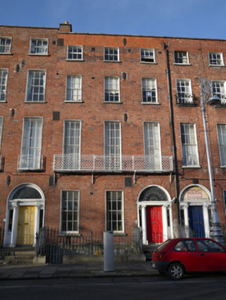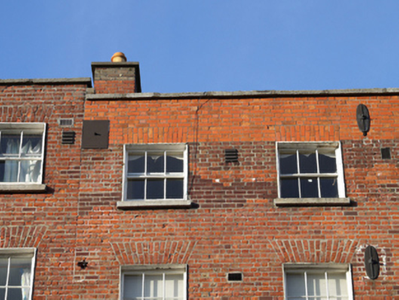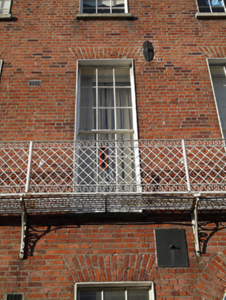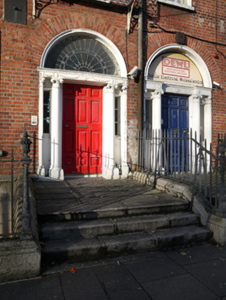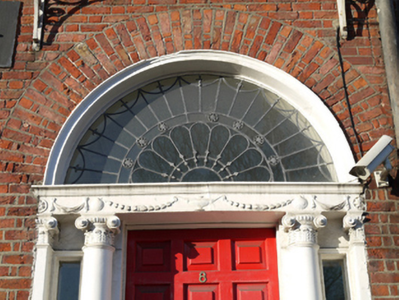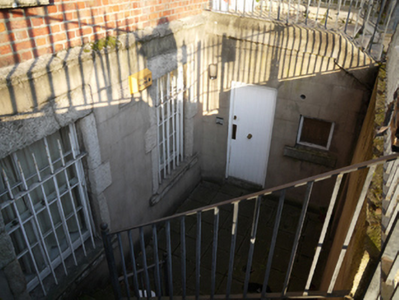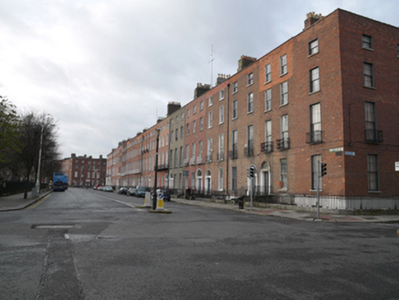Survey Data
Reg No
50010815
Rating
Regional
Categories of Special Interest
Architectural, Artistic
Original Use
House
Historical Use
School
In Use As
Apartment/flat (converted)
Date
1790 - 1795
Coordinates
316016, 235516
Date Recorded
05/12/2011
Date Updated
--/--/--
Description
Terraced three-bay four-storey house over raised basement, built c.1792, now in multiple occupancy. Double-pile slate roof, hipped to east to front (south) elevation having two hipped projections set perpendicular to rear and shared red-brick chimneystack with clay pots to west party wall, hidden behind rebuilt machine-made red brick parapet wall having granite coping. Octagonal cast-iron hopper and downpipe to east side of front elevation. Red brick walls laid in Flemish bond with flush pointing and cast-iron wall ties to moulded granite plinth course over ruled-and-lined rendered wall to basement, walling rebuilt above top floor windows. Red brick finish to rear elevation. Gauged brick flat-arch window openings having patent rendered reveals, granite sills and replacement timber sliding sash windows, six-over-six pane to basement, ground and second floors, nine-over-nine pane to first floor, three-over-three pane to top floor. Continuous cast-iron balconette to first floor windows. Block-and-start granite surrounds and steel grilles to windows to basement. Gauged brick round-arched door opening having moulded masonry surround, rendered reveal and painted stone Ionic doorcase, with replacement timber panelled door flanked by engaged Ionic columns, tripartite sidelights and quarter engaged responding Ionic pilasters supporting lintel cornice with swags, garlands, scallops and central urn detailing, and replacement fanlight having moulded masonry surround. Door opens onto granite platform having three granite steps bridging basement. Platform and basement enclosed by original wrought-iron railings and cast-iron corner posts set on moulded granite plinth wall to street with matching iron gate providing basement access. Concrete steps having metal railings to basement. Square-headed window and door openings to entrance platform with timber framed window and timber door.
Appraisal
The fine doorcase and a full-width decorative balconette form the decorative focus of this well-presented Georgian townhouse on Mountjoy Square. Its relatively intact appearance, enhancing this side of the square, is emphasised by the retention of timber sash windows and of the stone plinth and railings to the basement area and of the stone landing and steps to the entrance. and is Mountjoy Square was built on lands formerly belonging to St. Mary’s Abbey and laid out in 1790 by Luke Gardiner II, completed by 1818. Originally called Gardiner Square the plan was to develop a strong vista from Custom House to Mountjoy Square then on to the planned Royal Circus. Unlike other Georgian squares in the city, this example was more carefully laid out with a unified parapet height and the east-west approaches offset to create a sense of enclosure. After falling into serious neglect and dereliction throughout the twentieth-century resulting in the loss of one third of its original buildings, the square has since been repaired.

